Superannuation & Retirement Planning DFP3_AS_v4 Solved Assignment
VerifiedAdded on 2023/06/08
|77
|21153
|223
Practical Assignment
AI Summary
This document provides a comprehensive solution to a written assignment focused on superannuation and retirement planning (DFP3_AS_v4). The assignment requires students to analyze a case study involving Nathan and Mary Davidson, a couple concerned about their retirement savings. The solution addresses key areas such as establishing client relationships, identifying financial objectives, analyzing financial situations and risk profiles, addressing client questions about superannuation, presenting appropriate strategies and solutions, and agreeing on a financial plan. The assignment also includes fact-finder templates, cash flow templates, and managed funds calculations to support the development of a sound financial plan for the Davidsons. The solution aims to demonstrate competency in providing financial advice, developing financial plans, implementing financial plans, reviewing financial plans, and providing advice in superannuation.
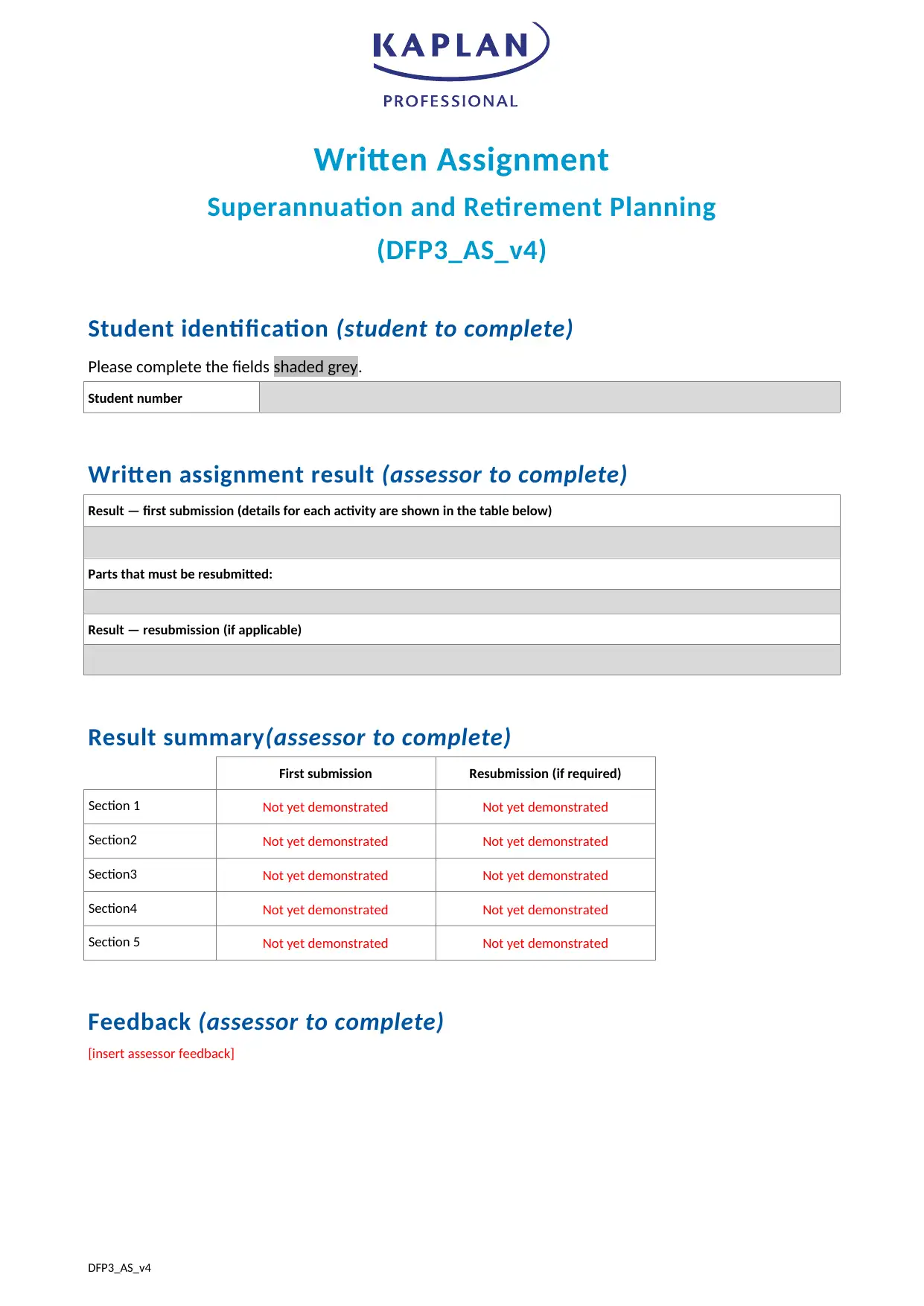
Written Assignment
Superannuation and Retirement Planning
(DFP3_AS_v4)
Student identification (student to complete)
Please complete the fields shaded grey.
Student number
Written assignment result (assessor to complete)
Result — first submission (details for each activity are shown in the table below)
Parts that must be resubmitted:
Result — resubmission (if applicable)
Result summary(assessor to complete)
First submission Resubmission (if required)
Section 1 Not yet demonstrated Not yet demonstrated
Section2 Not yet demonstrated Not yet demonstrated
Section3 Not yet demonstrated Not yet demonstrated
Section4 Not yet demonstrated Not yet demonstrated
Section 5 Not yet demonstrated Not yet demonstrated
Feedback (assessor to complete)
[insert assessor feedback]
DFP3_AS_v4
Superannuation and Retirement Planning
(DFP3_AS_v4)
Student identification (student to complete)
Please complete the fields shaded grey.
Student number
Written assignment result (assessor to complete)
Result — first submission (details for each activity are shown in the table below)
Parts that must be resubmitted:
Result — resubmission (if applicable)
Result summary(assessor to complete)
First submission Resubmission (if required)
Section 1 Not yet demonstrated Not yet demonstrated
Section2 Not yet demonstrated Not yet demonstrated
Section3 Not yet demonstrated Not yet demonstrated
Section4 Not yet demonstrated Not yet demonstrated
Section 5 Not yet demonstrated Not yet demonstrated
Feedback (assessor to complete)
[insert assessor feedback]
DFP3_AS_v4
Paraphrase This Document
Need a fresh take? Get an instant paraphrase of this document with our AI Paraphraser
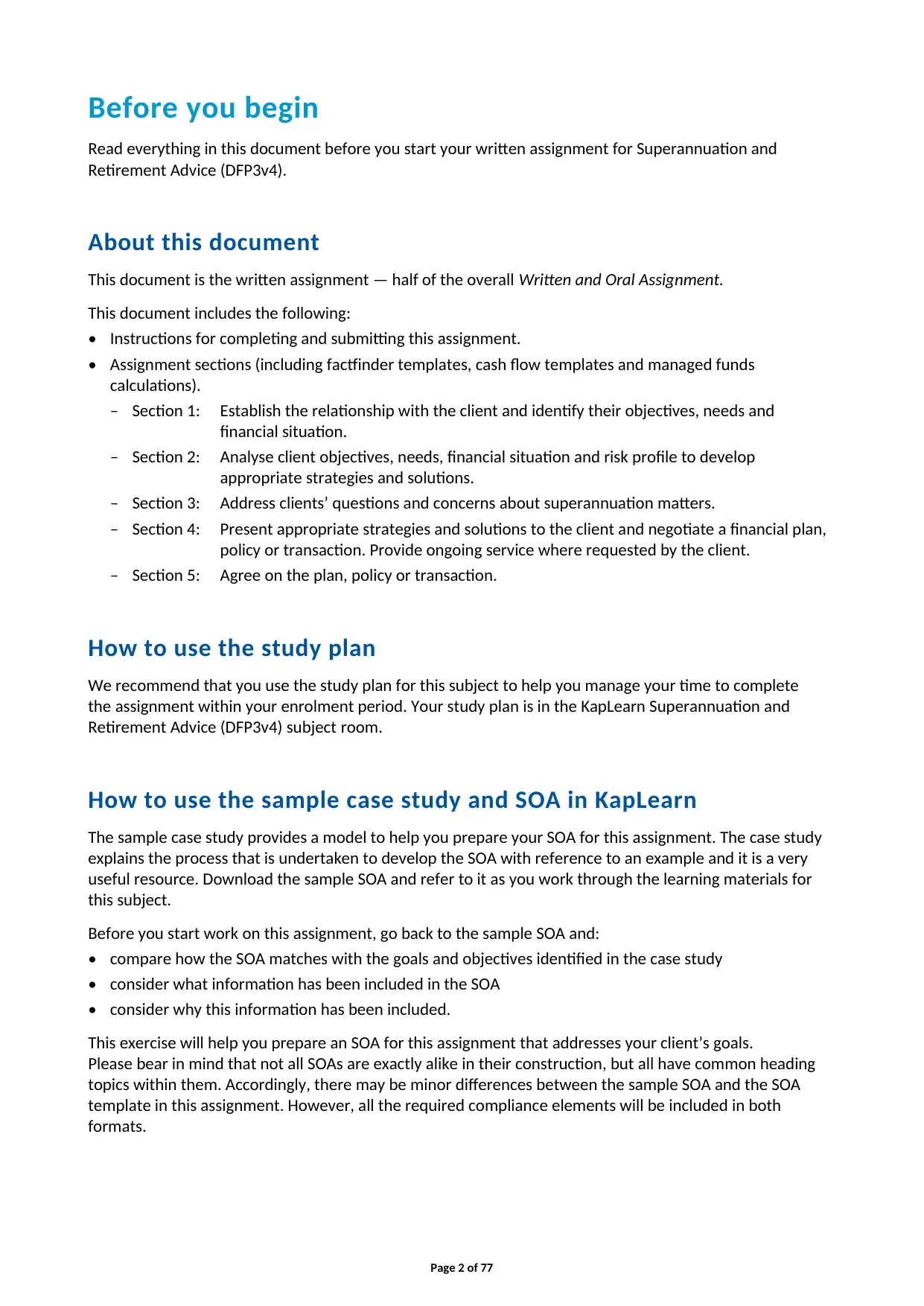
Before you begin
Read everything in this document before you start your written assignment for Superannuation and
Retirement Advice (DFP3v4).
About this document
This document is the written assignment — half of the overall Written and Oral Assignment.
This document includes the following:
• Instructions for completing and submitting this assignment.
• Assignment sections (including factfinder templates, cash flow templates and managed funds
calculations).
– Section 1: Establish the relationship with the client and identify their objectives, needs and
financial situation.
– Section 2: Analyse client objectives, needs, financial situation and risk profile to develop
appropriate strategies and solutions.
– Section 3: Address clients’ questions and concerns about superannuation matters.
– Section 4: Present appropriate strategies and solutions to the client and negotiate a financial plan,
policy or transaction. Provide ongoing service where requested by the client.
– Section 5: Agree on the plan, policy or transaction.
How to use the study plan
We recommend that you use the study plan for this subject to help you manage your time to complete
the assignment within your enrolment period. Your study plan is in the KapLearn Superannuation and
Retirement Advice (DFP3v4) subject room.
How to use the sample case study and SOA in KapLearn
The sample case study provides a model to help you prepare your SOA for this assignment. The case study
explains the process that is undertaken to develop the SOA with reference to an example and it is a very
useful resource. Download the sample SOA and refer to it as you work through the learning materials for
this subject.
Before you start work on this assignment, go back to the sample SOA and:
• compare how the SOA matches with the goals and objectives identified in the case study
• consider what information has been included in the SOA
• consider why this information has been included.
This exercise will help you prepare an SOA for this assignment that addresses your client’s goals.
Please bear in mind that not all SOAs are exactly alike in their construction, but all have common heading
topics within them. Accordingly, there may be minor differences between the sample SOA and the SOA
template in this assignment. However, all the required compliance elements will be included in both
formats.
Page 2 of 77
Read everything in this document before you start your written assignment for Superannuation and
Retirement Advice (DFP3v4).
About this document
This document is the written assignment — half of the overall Written and Oral Assignment.
This document includes the following:
• Instructions for completing and submitting this assignment.
• Assignment sections (including factfinder templates, cash flow templates and managed funds
calculations).
– Section 1: Establish the relationship with the client and identify their objectives, needs and
financial situation.
– Section 2: Analyse client objectives, needs, financial situation and risk profile to develop
appropriate strategies and solutions.
– Section 3: Address clients’ questions and concerns about superannuation matters.
– Section 4: Present appropriate strategies and solutions to the client and negotiate a financial plan,
policy or transaction. Provide ongoing service where requested by the client.
– Section 5: Agree on the plan, policy or transaction.
How to use the study plan
We recommend that you use the study plan for this subject to help you manage your time to complete
the assignment within your enrolment period. Your study plan is in the KapLearn Superannuation and
Retirement Advice (DFP3v4) subject room.
How to use the sample case study and SOA in KapLearn
The sample case study provides a model to help you prepare your SOA for this assignment. The case study
explains the process that is undertaken to develop the SOA with reference to an example and it is a very
useful resource. Download the sample SOA and refer to it as you work through the learning materials for
this subject.
Before you start work on this assignment, go back to the sample SOA and:
• compare how the SOA matches with the goals and objectives identified in the case study
• consider what information has been included in the SOA
• consider why this information has been included.
This exercise will help you prepare an SOA for this assignment that addresses your client’s goals.
Please bear in mind that not all SOAs are exactly alike in their construction, but all have common heading
topics within them. Accordingly, there may be minor differences between the sample SOA and the SOA
template in this assignment. However, all the required compliance elements will be included in both
formats.
Page 2 of 77
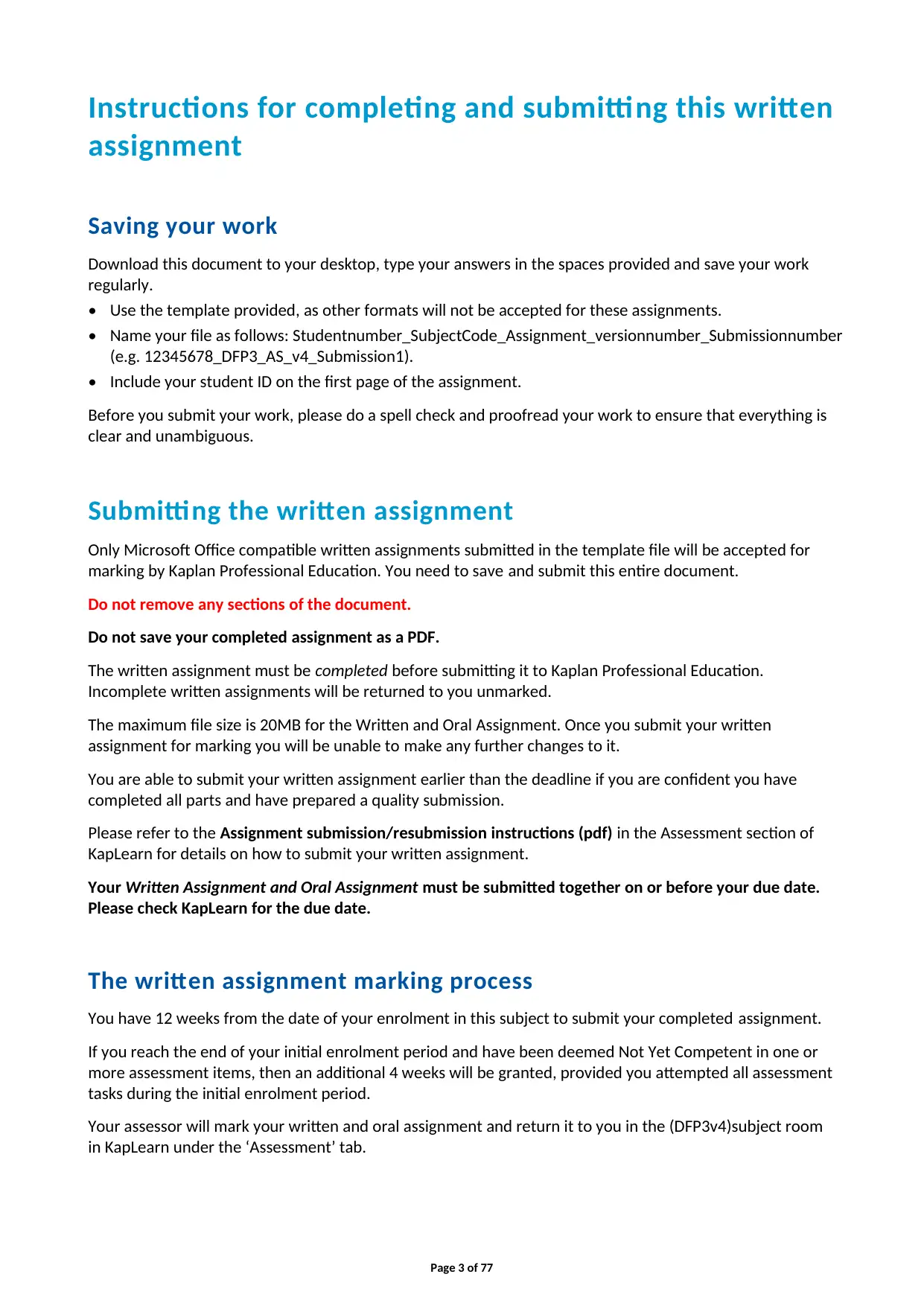
Instructions for completing and submitting this written
assignment
Saving your work
Download this document to your desktop, type your answers in the spaces provided and save your work
regularly.
• Use the template provided, as other formats will not be accepted for these assignments.
• Name your file as follows: Studentnumber_SubjectCode_Assignment_versionnumber_Submissionnumber
(e.g. 12345678_DFP3_AS_v4_Submission1).
• Include your student ID on the first page of the assignment.
Before you submit your work, please do a spell check and proofread your work to ensure that everything is
clear and unambiguous.
Submitting the written assignment
Only Microsoft Office compatible written assignments submitted in the template file will be accepted for
marking by Kaplan Professional Education. You need to save and submit this entire document.
Do not remove any sections of the document.
Do not save your completed assignment as a PDF.
The written assignment must be completed before submitting it to Kaplan Professional Education.
Incomplete written assignments will be returned to you unmarked.
The maximum file size is 20MB for the Written and Oral Assignment. Once you submit your written
assignment for marking you will be unable to make any further changes to it.
You are able to submit your written assignment earlier than the deadline if you are confident you have
completed all parts and have prepared a quality submission.
Please refer to the Assignment submission/resubmission instructions (pdf) in the Assessment section of
KapLearn for details on how to submit your written assignment.
Your Written Assignment and Oral Assignment must be submitted together on or before your due date.
Please check KapLearn for the due date.
The written assignment marking process
You have 12 weeks from the date of your enrolment in this subject to submit your completed assignment.
If you reach the end of your initial enrolment period and have been deemed Not Yet Competent in one or
more assessment items, then an additional 4 weeks will be granted, provided you attempted all assessment
tasks during the initial enrolment period.
Your assessor will mark your written and oral assignment and return it to you in the (DFP3v4)subject room
in KapLearn under the ‘Assessment’ tab.
Page 3 of 77
assignment
Saving your work
Download this document to your desktop, type your answers in the spaces provided and save your work
regularly.
• Use the template provided, as other formats will not be accepted for these assignments.
• Name your file as follows: Studentnumber_SubjectCode_Assignment_versionnumber_Submissionnumber
(e.g. 12345678_DFP3_AS_v4_Submission1).
• Include your student ID on the first page of the assignment.
Before you submit your work, please do a spell check and proofread your work to ensure that everything is
clear and unambiguous.
Submitting the written assignment
Only Microsoft Office compatible written assignments submitted in the template file will be accepted for
marking by Kaplan Professional Education. You need to save and submit this entire document.
Do not remove any sections of the document.
Do not save your completed assignment as a PDF.
The written assignment must be completed before submitting it to Kaplan Professional Education.
Incomplete written assignments will be returned to you unmarked.
The maximum file size is 20MB for the Written and Oral Assignment. Once you submit your written
assignment for marking you will be unable to make any further changes to it.
You are able to submit your written assignment earlier than the deadline if you are confident you have
completed all parts and have prepared a quality submission.
Please refer to the Assignment submission/resubmission instructions (pdf) in the Assessment section of
KapLearn for details on how to submit your written assignment.
Your Written Assignment and Oral Assignment must be submitted together on or before your due date.
Please check KapLearn for the due date.
The written assignment marking process
You have 12 weeks from the date of your enrolment in this subject to submit your completed assignment.
If you reach the end of your initial enrolment period and have been deemed Not Yet Competent in one or
more assessment items, then an additional 4 weeks will be granted, provided you attempted all assessment
tasks during the initial enrolment period.
Your assessor will mark your written and oral assignment and return it to you in the (DFP3v4)subject room
in KapLearn under the ‘Assessment’ tab.
Page 3 of 77
⊘ This is a preview!⊘
Do you want full access?
Subscribe today to unlock all pages.

Trusted by 1+ million students worldwide
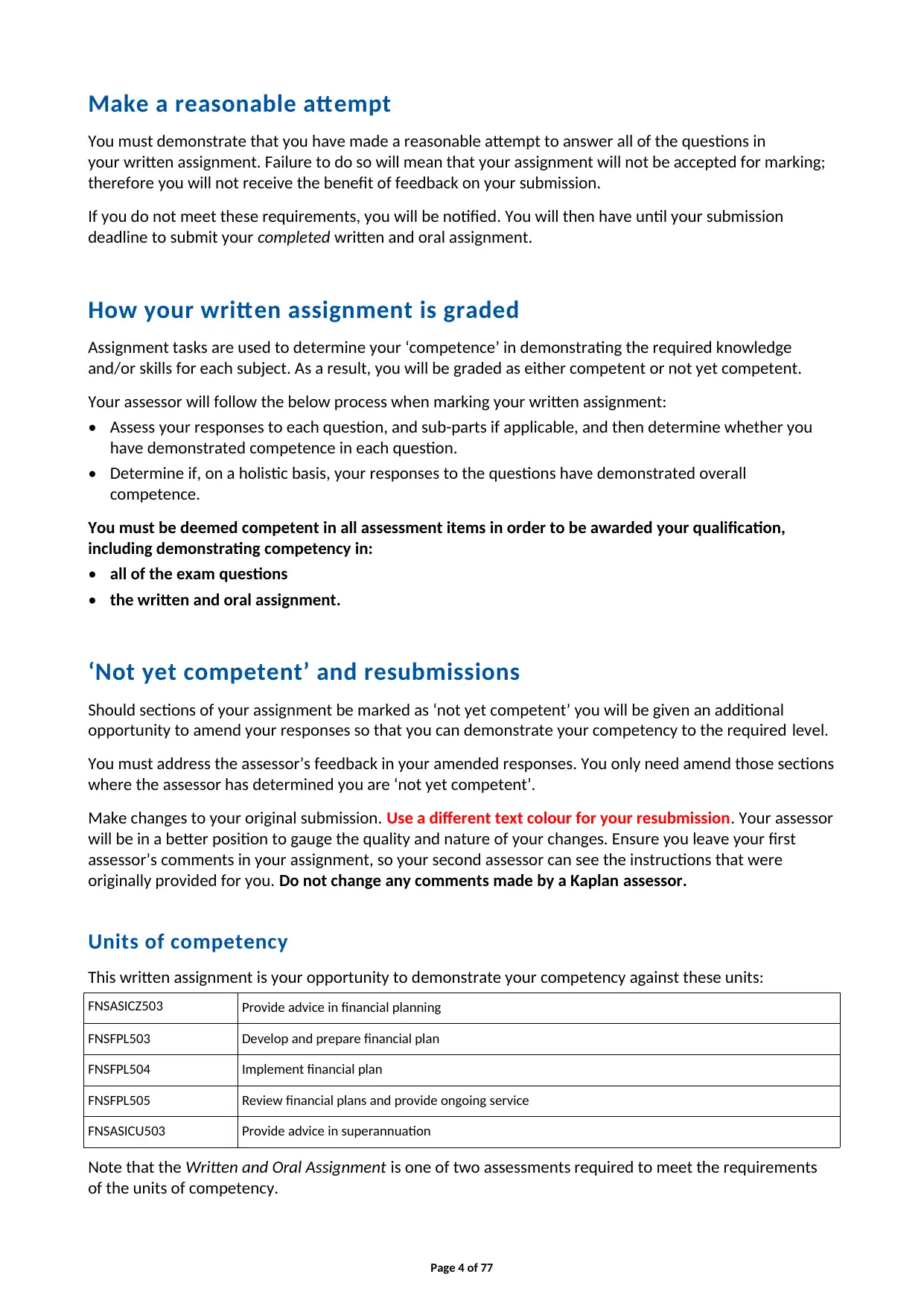
Make a reasonable attempt
You must demonstrate that you have made a reasonable attempt to answer all of the questions in
your written assignment. Failure to do so will mean that your assignment will not be accepted for marking;
therefore you will not receive the benefit of feedback on your submission.
If you do not meet these requirements, you will be notified. You will then have until your submission
deadline to submit your completed written and oral assignment.
How your written assignment is graded
Assignment tasks are used to determine your ‘competence’ in demonstrating the required knowledge
and/or skills for each subject. As a result, you will be graded as either competent or not yet competent.
Your assessor will follow the below process when marking your written assignment:
• Assess your responses to each question, and sub-parts if applicable, and then determine whether you
have demonstrated competence in each question.
• Determine if, on a holistic basis, your responses to the questions have demonstrated overall
competence.
You must be deemed competent in all assessment items in order to be awarded your qualification,
including demonstrating competency in:
• all of the exam questions
• the written and oral assignment.
‘Not yet competent’ and resubmissions
Should sections of your assignment be marked as ‘not yet competent’ you will be given an additional
opportunity to amend your responses so that you can demonstrate your competency to the required level.
You must address the assessor’s feedback in your amended responses. You only need amend those sections
where the assessor has determined you are ‘not yet competent’.
Make changes to your original submission. Use a different text colour for your resubmission. Your assessor
will be in a better position to gauge the quality and nature of your changes. Ensure you leave your first
assessor’s comments in your assignment, so your second assessor can see the instructions that were
originally provided for you. Do not change any comments made by a Kaplan assessor.
Units of competency
This written assignment is your opportunity to demonstrate your competency against these units:
FNSASICZ503 Provide advice in financial planning
FNSFPL503 Develop and prepare financial plan
FNSFPL504 Implement financial plan
FNSFPL505 Review financial plans and provide ongoing service
FNSASICU503 Provide advice in superannuation
Note that the Written and Oral Assignment is one of two assessments required to meet the requirements
of the units of competency.
Page 4 of 77
You must demonstrate that you have made a reasonable attempt to answer all of the questions in
your written assignment. Failure to do so will mean that your assignment will not be accepted for marking;
therefore you will not receive the benefit of feedback on your submission.
If you do not meet these requirements, you will be notified. You will then have until your submission
deadline to submit your completed written and oral assignment.
How your written assignment is graded
Assignment tasks are used to determine your ‘competence’ in demonstrating the required knowledge
and/or skills for each subject. As a result, you will be graded as either competent or not yet competent.
Your assessor will follow the below process when marking your written assignment:
• Assess your responses to each question, and sub-parts if applicable, and then determine whether you
have demonstrated competence in each question.
• Determine if, on a holistic basis, your responses to the questions have demonstrated overall
competence.
You must be deemed competent in all assessment items in order to be awarded your qualification,
including demonstrating competency in:
• all of the exam questions
• the written and oral assignment.
‘Not yet competent’ and resubmissions
Should sections of your assignment be marked as ‘not yet competent’ you will be given an additional
opportunity to amend your responses so that you can demonstrate your competency to the required level.
You must address the assessor’s feedback in your amended responses. You only need amend those sections
where the assessor has determined you are ‘not yet competent’.
Make changes to your original submission. Use a different text colour for your resubmission. Your assessor
will be in a better position to gauge the quality and nature of your changes. Ensure you leave your first
assessor’s comments in your assignment, so your second assessor can see the instructions that were
originally provided for you. Do not change any comments made by a Kaplan assessor.
Units of competency
This written assignment is your opportunity to demonstrate your competency against these units:
FNSASICZ503 Provide advice in financial planning
FNSFPL503 Develop and prepare financial plan
FNSFPL504 Implement financial plan
FNSFPL505 Review financial plans and provide ongoing service
FNSASICU503 Provide advice in superannuation
Note that the Written and Oral Assignment is one of two assessments required to meet the requirements
of the units of competency.
Page 4 of 77
Paraphrase This Document
Need a fresh take? Get an instant paraphrase of this document with our AI Paraphraser

We are here to help
If you have any questions about this written assignment, you can post your query at the ‘Ask your Tutor’
forum in your subject room. You can expect an answer within 24 hours of your posting from one of our
technical advisers or student support staff.
Page 5 of 77
If you have any questions about this written assignment, you can post your query at the ‘Ask your Tutor’
forum in your subject room. You can expect an answer within 24 hours of your posting from one of our
technical advisers or student support staff.
Page 5 of 77
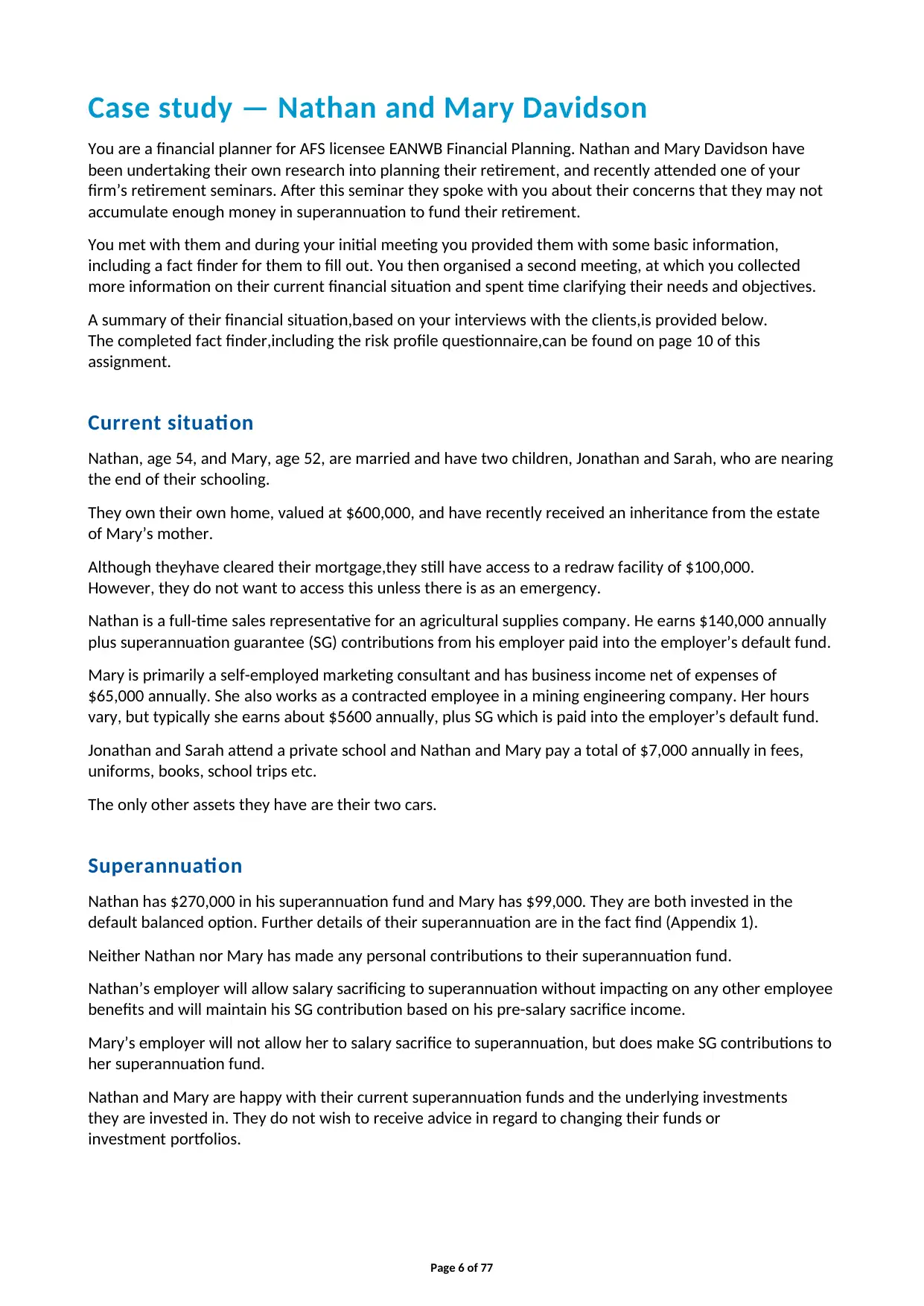
Case study — Nathan and Mary Davidson
You are a financial planner for AFS licensee EANWB Financial Planning. Nathan and Mary Davidson have
been undertaking their own research into planning their retirement, and recently attended one of your
firm’s retirement seminars. After this seminar they spoke with you about their concerns that they may not
accumulate enough money in superannuation to fund their retirement.
You met with them and during your initial meeting you provided them with some basic information,
including a fact finder for them to fill out. You then organised a second meeting, at which you collected
more information on their current financial situation and spent time clarifying their needs and objectives.
A summary of their financial situation,based on your interviews with the clients,is provided below.
The completed fact finder,including the risk profile questionnaire,can be found on page 10 of this
assignment.
Current situation
Nathan, age 54, and Mary, age 52, are married and have two children, Jonathan and Sarah, who are nearing
the end of their schooling.
They own their own home, valued at $600,000, and have recently received an inheritance from the estate
of Mary’s mother.
Although theyhave cleared their mortgage,they still have access to a redraw facility of $100,000.
However, they do not want to access this unless there is as an emergency.
Nathan is a full-time sales representative for an agricultural supplies company. He earns $140,000 annually
plus superannuation guarantee (SG) contributions from his employer paid into the employer’s default fund.
Mary is primarily a self-employed marketing consultant and has business income net of expenses of
$65,000 annually. She also works as a contracted employee in a mining engineering company. Her hours
vary, but typically she earns about $5600 annually, plus SG which is paid into the employer’s default fund.
Jonathan and Sarah attend a private school and Nathan and Mary pay a total of $7,000 annually in fees,
uniforms, books, school trips etc.
The only other assets they have are their two cars.
Superannuation
Nathan has $270,000 in his superannuation fund and Mary has $99,000. They are both invested in the
default balanced option. Further details of their superannuation are in the fact find (Appendix 1).
Neither Nathan nor Mary has made any personal contributions to their superannuation fund.
Nathan’s employer will allow salary sacrificing to superannuation without impacting on any other employee
benefits and will maintain his SG contribution based on his pre-salary sacrifice income.
Mary’s employer will not allow her to salary sacrifice to superannuation, but does make SG contributions to
her superannuation fund.
Nathan and Mary are happy with their current superannuation funds and the underlying investments
they are invested in. They do not wish to receive advice in regard to changing their funds or
investment portfolios.
Page 6 of 77
You are a financial planner for AFS licensee EANWB Financial Planning. Nathan and Mary Davidson have
been undertaking their own research into planning their retirement, and recently attended one of your
firm’s retirement seminars. After this seminar they spoke with you about their concerns that they may not
accumulate enough money in superannuation to fund their retirement.
You met with them and during your initial meeting you provided them with some basic information,
including a fact finder for them to fill out. You then organised a second meeting, at which you collected
more information on their current financial situation and spent time clarifying their needs and objectives.
A summary of their financial situation,based on your interviews with the clients,is provided below.
The completed fact finder,including the risk profile questionnaire,can be found on page 10 of this
assignment.
Current situation
Nathan, age 54, and Mary, age 52, are married and have two children, Jonathan and Sarah, who are nearing
the end of their schooling.
They own their own home, valued at $600,000, and have recently received an inheritance from the estate
of Mary’s mother.
Although theyhave cleared their mortgage,they still have access to a redraw facility of $100,000.
However, they do not want to access this unless there is as an emergency.
Nathan is a full-time sales representative for an agricultural supplies company. He earns $140,000 annually
plus superannuation guarantee (SG) contributions from his employer paid into the employer’s default fund.
Mary is primarily a self-employed marketing consultant and has business income net of expenses of
$65,000 annually. She also works as a contracted employee in a mining engineering company. Her hours
vary, but typically she earns about $5600 annually, plus SG which is paid into the employer’s default fund.
Jonathan and Sarah attend a private school and Nathan and Mary pay a total of $7,000 annually in fees,
uniforms, books, school trips etc.
The only other assets they have are their two cars.
Superannuation
Nathan has $270,000 in his superannuation fund and Mary has $99,000. They are both invested in the
default balanced option. Further details of their superannuation are in the fact find (Appendix 1).
Neither Nathan nor Mary has made any personal contributions to their superannuation fund.
Nathan’s employer will allow salary sacrificing to superannuation without impacting on any other employee
benefits and will maintain his SG contribution based on his pre-salary sacrifice income.
Mary’s employer will not allow her to salary sacrifice to superannuation, but does make SG contributions to
her superannuation fund.
Nathan and Mary are happy with their current superannuation funds and the underlying investments
they are invested in. They do not wish to receive advice in regard to changing their funds or
investment portfolios.
Page 6 of 77
⊘ This is a preview!⊘
Do you want full access?
Subscribe today to unlock all pages.

Trusted by 1+ million students worldwide
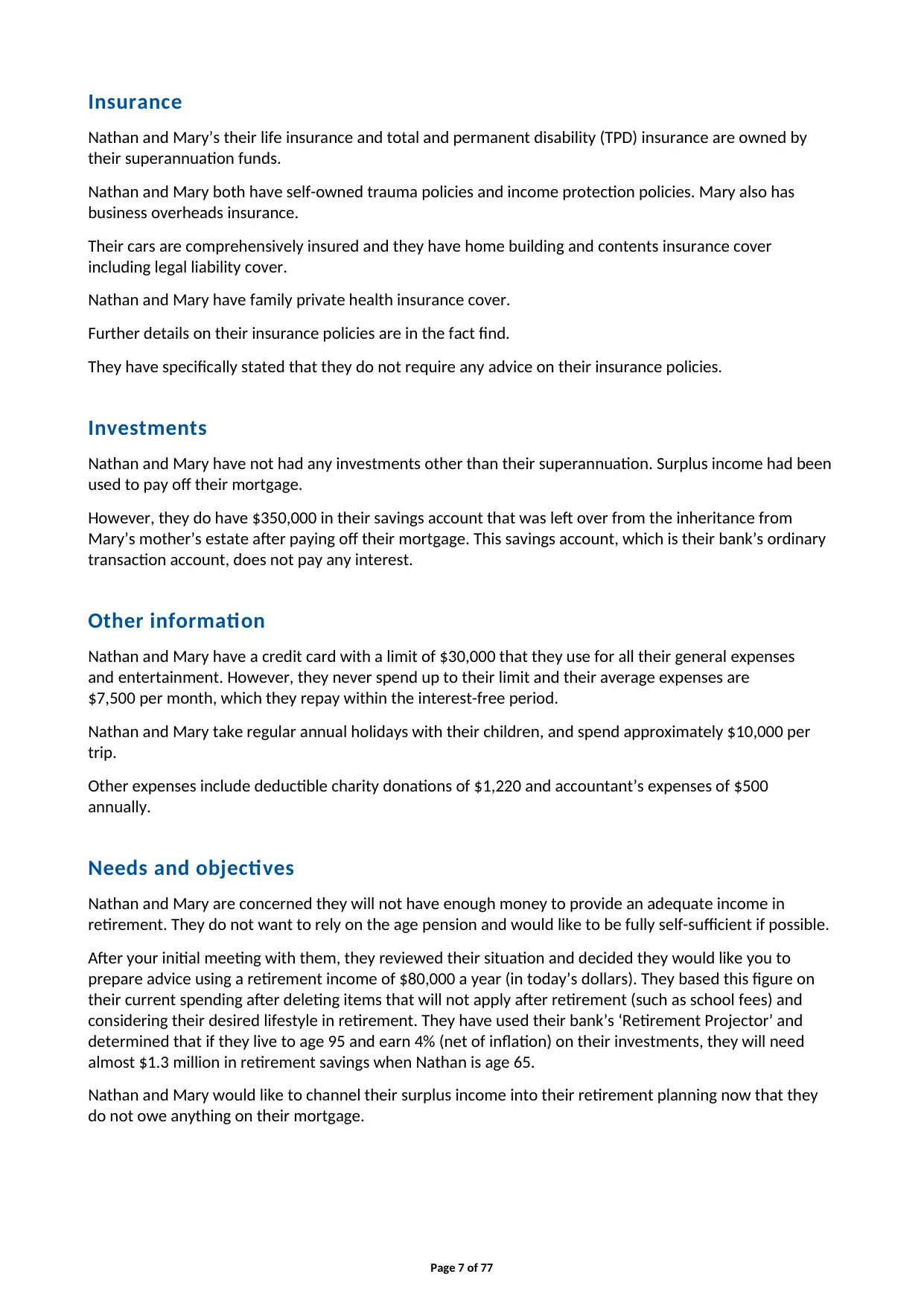
Insurance
Nathan and Mary’s their life insurance and total and permanent disability (TPD) insurance are owned by
their superannuation funds.
Nathan and Mary both have self-owned trauma policies and income protection policies. Mary also has
business overheads insurance.
Their cars are comprehensively insured and they have home building and contents insurance cover
including legal liability cover.
Nathan and Mary have family private health insurance cover.
Further details on their insurance policies are in the fact find.
They have specifically stated that they do not require any advice on their insurance policies.
Investments
Nathan and Mary have not had any investments other than their superannuation. Surplus income had been
used to pay off their mortgage.
However, they do have $350,000 in their savings account that was left over from the inheritance from
Mary’s mother’s estate after paying off their mortgage. This savings account, which is their bank’s ordinary
transaction account, does not pay any interest.
Other information
Nathan and Mary have a credit card with a limit of $30,000 that they use for all their general expenses
and entertainment. However, they never spend up to their limit and their average expenses are
$7,500 per month, which they repay within the interest-free period.
Nathan and Mary take regular annual holidays with their children, and spend approximately $10,000 per
trip.
Other expenses include deductible charity donations of $1,220 and accountant’s expenses of $500
annually.
Needs and objectives
Nathan and Mary are concerned they will not have enough money to provide an adequate income in
retirement. They do not want to rely on the age pension and would like to be fully self-sufficient if possible.
After your initial meeting with them, they reviewed their situation and decided they would like you to
prepare advice using a retirement income of $80,000 a year (in today’s dollars). They based this figure on
their current spending after deleting items that will not apply after retirement (such as school fees) and
considering their desired lifestyle in retirement. They have used their bank’s ‘Retirement Projector’ and
determined that if they live to age 95 and earn 4% (net of inflation) on their investments, they will need
almost $1.3 million in retirement savings when Nathan is age 65.
Nathan and Mary would like to channel their surplus income into their retirement planning now that they
do not owe anything on their mortgage.
Page 7 of 77
Nathan and Mary’s their life insurance and total and permanent disability (TPD) insurance are owned by
their superannuation funds.
Nathan and Mary both have self-owned trauma policies and income protection policies. Mary also has
business overheads insurance.
Their cars are comprehensively insured and they have home building and contents insurance cover
including legal liability cover.
Nathan and Mary have family private health insurance cover.
Further details on their insurance policies are in the fact find.
They have specifically stated that they do not require any advice on their insurance policies.
Investments
Nathan and Mary have not had any investments other than their superannuation. Surplus income had been
used to pay off their mortgage.
However, they do have $350,000 in their savings account that was left over from the inheritance from
Mary’s mother’s estate after paying off their mortgage. This savings account, which is their bank’s ordinary
transaction account, does not pay any interest.
Other information
Nathan and Mary have a credit card with a limit of $30,000 that they use for all their general expenses
and entertainment. However, they never spend up to their limit and their average expenses are
$7,500 per month, which they repay within the interest-free period.
Nathan and Mary take regular annual holidays with their children, and spend approximately $10,000 per
trip.
Other expenses include deductible charity donations of $1,220 and accountant’s expenses of $500
annually.
Needs and objectives
Nathan and Mary are concerned they will not have enough money to provide an adequate income in
retirement. They do not want to rely on the age pension and would like to be fully self-sufficient if possible.
After your initial meeting with them, they reviewed their situation and decided they would like you to
prepare advice using a retirement income of $80,000 a year (in today’s dollars). They based this figure on
their current spending after deleting items that will not apply after retirement (such as school fees) and
considering their desired lifestyle in retirement. They have used their bank’s ‘Retirement Projector’ and
determined that if they live to age 95 and earn 4% (net of inflation) on their investments, they will need
almost $1.3 million in retirement savings when Nathan is age 65.
Nathan and Mary would like to channel their surplus income into their retirement planning now that they
do not owe anything on their mortgage.
Page 7 of 77
Paraphrase This Document
Need a fresh take? Get an instant paraphrase of this document with our AI Paraphraser
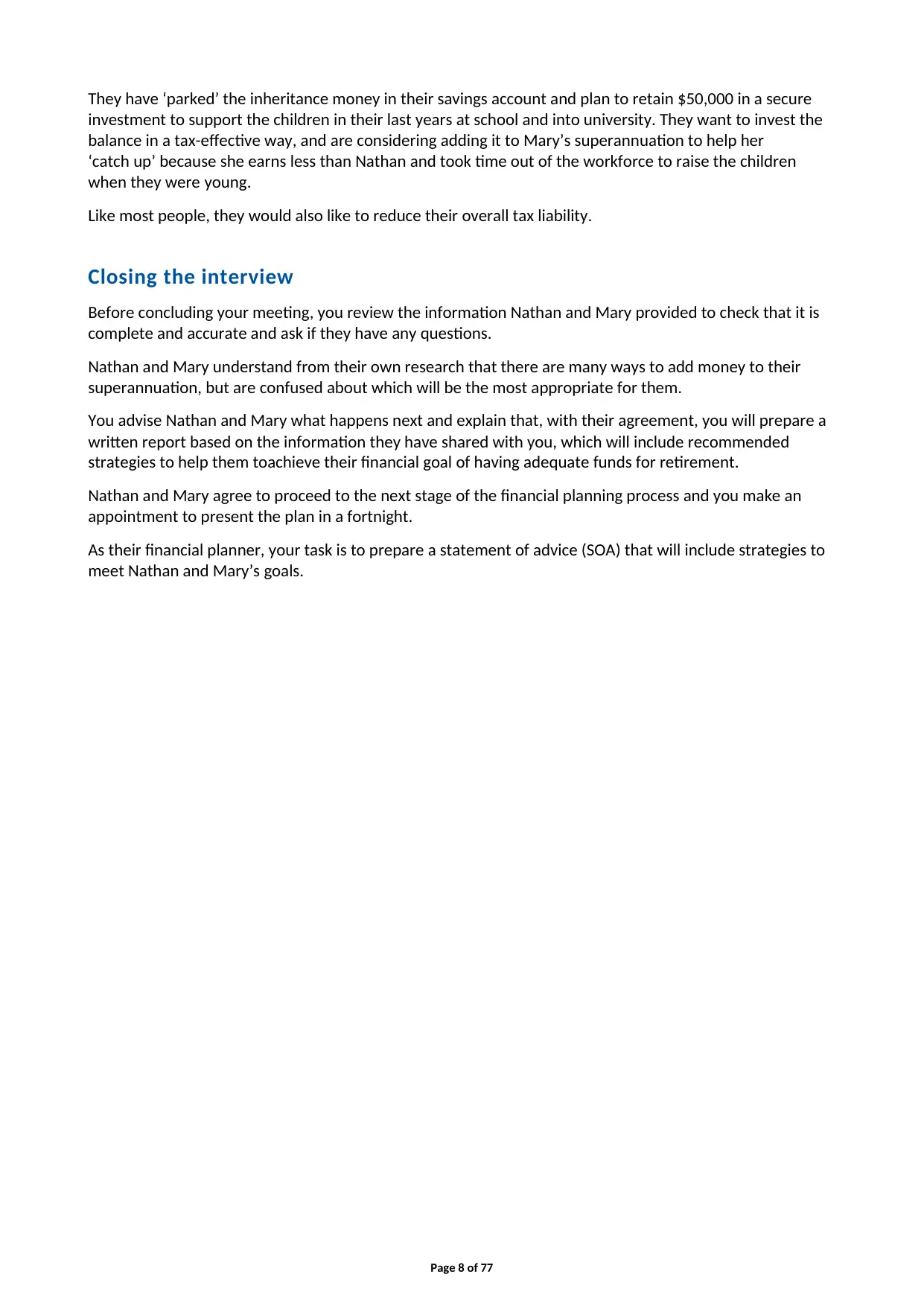
They have ‘parked’ the inheritance money in their savings account and plan to retain $50,000 in a secure
investment to support the children in their last years at school and into university. They want to invest the
balance in a tax-effective way, and are considering adding it to Mary’s superannuation to help her
‘catch up’ because she earns less than Nathan and took time out of the workforce to raise the children
when they were young.
Like most people, they would also like to reduce their overall tax liability.
Closing the interview
Before concluding your meeting, you review the information Nathan and Mary provided to check that it is
complete and accurate and ask if they have any questions.
Nathan and Mary understand from their own research that there are many ways to add money to their
superannuation, but are confused about which will be the most appropriate for them.
You advise Nathan and Mary what happens next and explain that, with their agreement, you will prepare a
written report based on the information they have shared with you, which will include recommended
strategies to help them toachieve their financial goal of having adequate funds for retirement.
Nathan and Mary agree to proceed to the next stage of the financial planning process and you make an
appointment to present the plan in a fortnight.
As their financial planner, your task is to prepare a statement of advice (SOA) that will include strategies to
meet Nathan and Mary’s goals.
Page 8 of 77
investment to support the children in their last years at school and into university. They want to invest the
balance in a tax-effective way, and are considering adding it to Mary’s superannuation to help her
‘catch up’ because she earns less than Nathan and took time out of the workforce to raise the children
when they were young.
Like most people, they would also like to reduce their overall tax liability.
Closing the interview
Before concluding your meeting, you review the information Nathan and Mary provided to check that it is
complete and accurate and ask if they have any questions.
Nathan and Mary understand from their own research that there are many ways to add money to their
superannuation, but are confused about which will be the most appropriate for them.
You advise Nathan and Mary what happens next and explain that, with their agreement, you will prepare a
written report based on the information they have shared with you, which will include recommended
strategies to help them toachieve their financial goal of having adequate funds for retirement.
Nathan and Mary agree to proceed to the next stage of the financial planning process and you make an
appointment to present the plan in a fortnight.
As their financial planner, your task is to prepare a statement of advice (SOA) that will include strategies to
meet Nathan and Mary’s goals.
Page 8 of 77
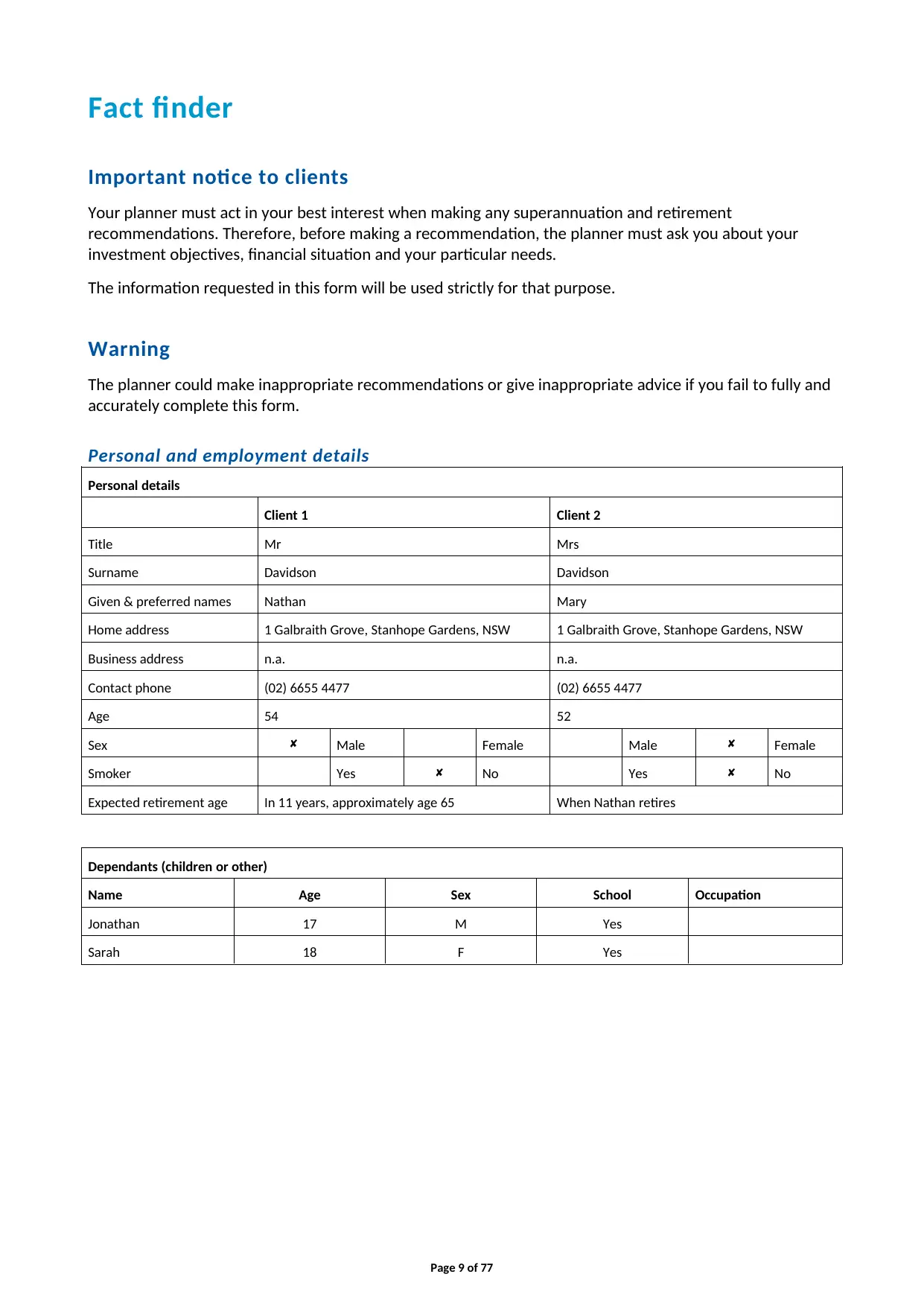
Fact finder
Important notice to clients
Your planner must act in your best interest when making any superannuation and retirement
recommendations. Therefore, before making a recommendation, the planner must ask you about your
investment objectives, financial situation and your particular needs.
The information requested in this form will be used strictly for that purpose.
Warning
The planner could make inappropriate recommendations or give inappropriate advice if you fail to fully and
accurately complete this form.
Personal and employment details
Personal details
Client 1 Client 2
Title Mr Mrs
Surname Davidson Davidson
Given & preferred names Nathan Mary
Home address 1 Galbraith Grove, Stanhope Gardens, NSW 1 Galbraith Grove, Stanhope Gardens, NSW
Business address n.a. n.a.
Contact phone (02) 6655 4477 (02) 6655 4477
Age 54 52
Sex Male Female Male Female
Smoker Yes No Yes No
Expected retirement age In 11 years, approximately age 65 When Nathan retires
Dependants (children or other)
Name Age Sex School Occupation
Jonathan 17 M Yes
Sarah 18 F Yes
Page 9 of 77
Important notice to clients
Your planner must act in your best interest when making any superannuation and retirement
recommendations. Therefore, before making a recommendation, the planner must ask you about your
investment objectives, financial situation and your particular needs.
The information requested in this form will be used strictly for that purpose.
Warning
The planner could make inappropriate recommendations or give inappropriate advice if you fail to fully and
accurately complete this form.
Personal and employment details
Personal details
Client 1 Client 2
Title Mr Mrs
Surname Davidson Davidson
Given & preferred names Nathan Mary
Home address 1 Galbraith Grove, Stanhope Gardens, NSW 1 Galbraith Grove, Stanhope Gardens, NSW
Business address n.a. n.a.
Contact phone (02) 6655 4477 (02) 6655 4477
Age 54 52
Sex Male Female Male Female
Smoker Yes No Yes No
Expected retirement age In 11 years, approximately age 65 When Nathan retires
Dependants (children or other)
Name Age Sex School Occupation
Jonathan 17 M Yes
Sarah 18 F Yes
Page 9 of 77
⊘ This is a preview!⊘
Do you want full access?
Subscribe today to unlock all pages.

Trusted by 1+ million students worldwide
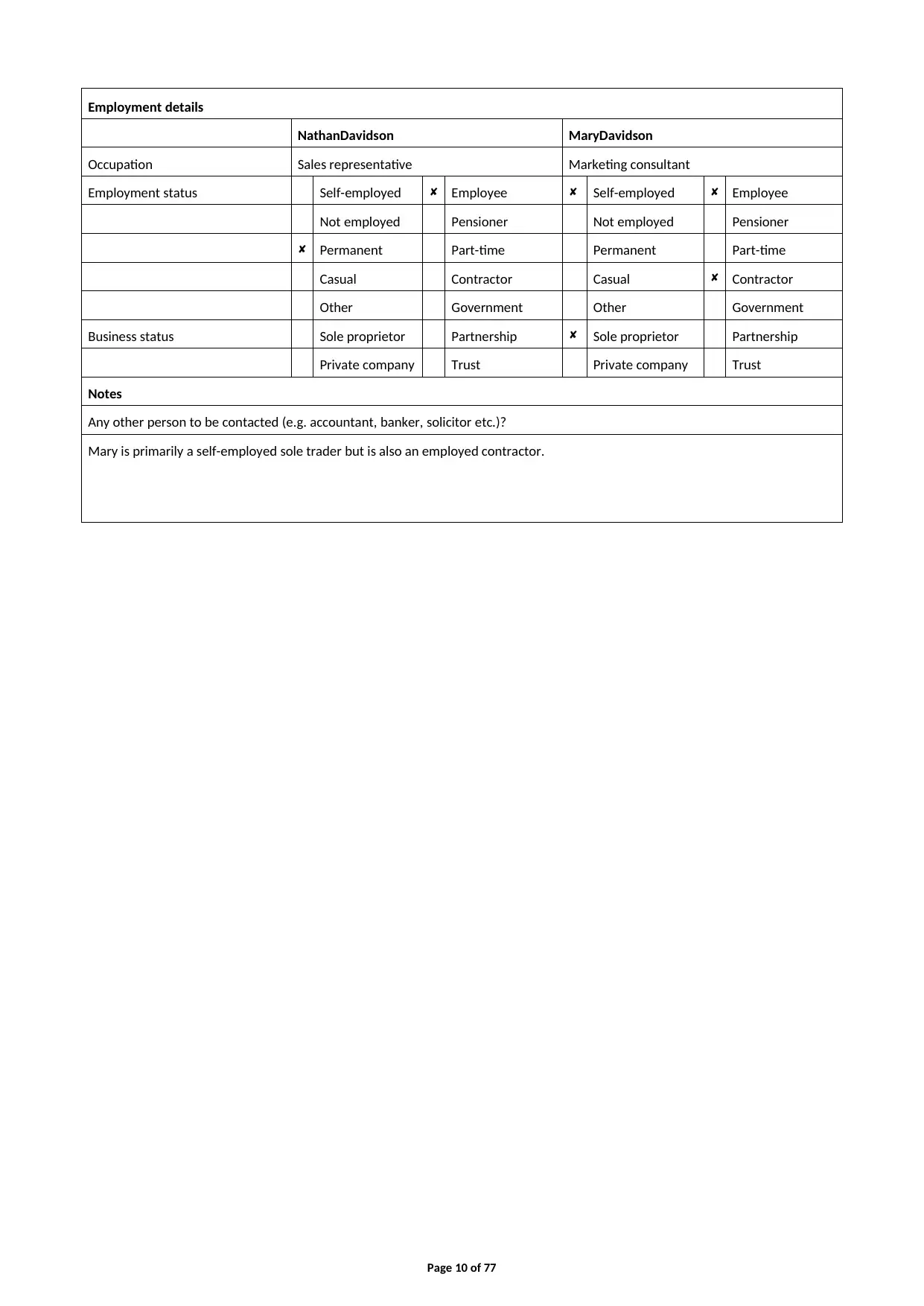
Employment details
NathanDavidson MaryDavidson
Occupation Sales representative Marketing consultant
Employment status Self-employed Employee Self-employed Employee
Not employed Pensioner Not employed Pensioner
Permanent Part-time Permanent Part-time
Casual Contractor Casual Contractor
Other Government Other Government
Business status Sole proprietor Partnership Sole proprietor Partnership
Private company Trust Private company Trust
Notes
Any other person to be contacted (e.g. accountant, banker, solicitor etc.)?
Mary is primarily a self-employed sole trader but is also an employed contractor.
Page 10 of 77
NathanDavidson MaryDavidson
Occupation Sales representative Marketing consultant
Employment status Self-employed Employee Self-employed Employee
Not employed Pensioner Not employed Pensioner
Permanent Part-time Permanent Part-time
Casual Contractor Casual Contractor
Other Government Other Government
Business status Sole proprietor Partnership Sole proprietor Partnership
Private company Trust Private company Trust
Notes
Any other person to be contacted (e.g. accountant, banker, solicitor etc.)?
Mary is primarily a self-employed sole trader but is also an employed contractor.
Page 10 of 77
Paraphrase This Document
Need a fresh take? Get an instant paraphrase of this document with our AI Paraphraser
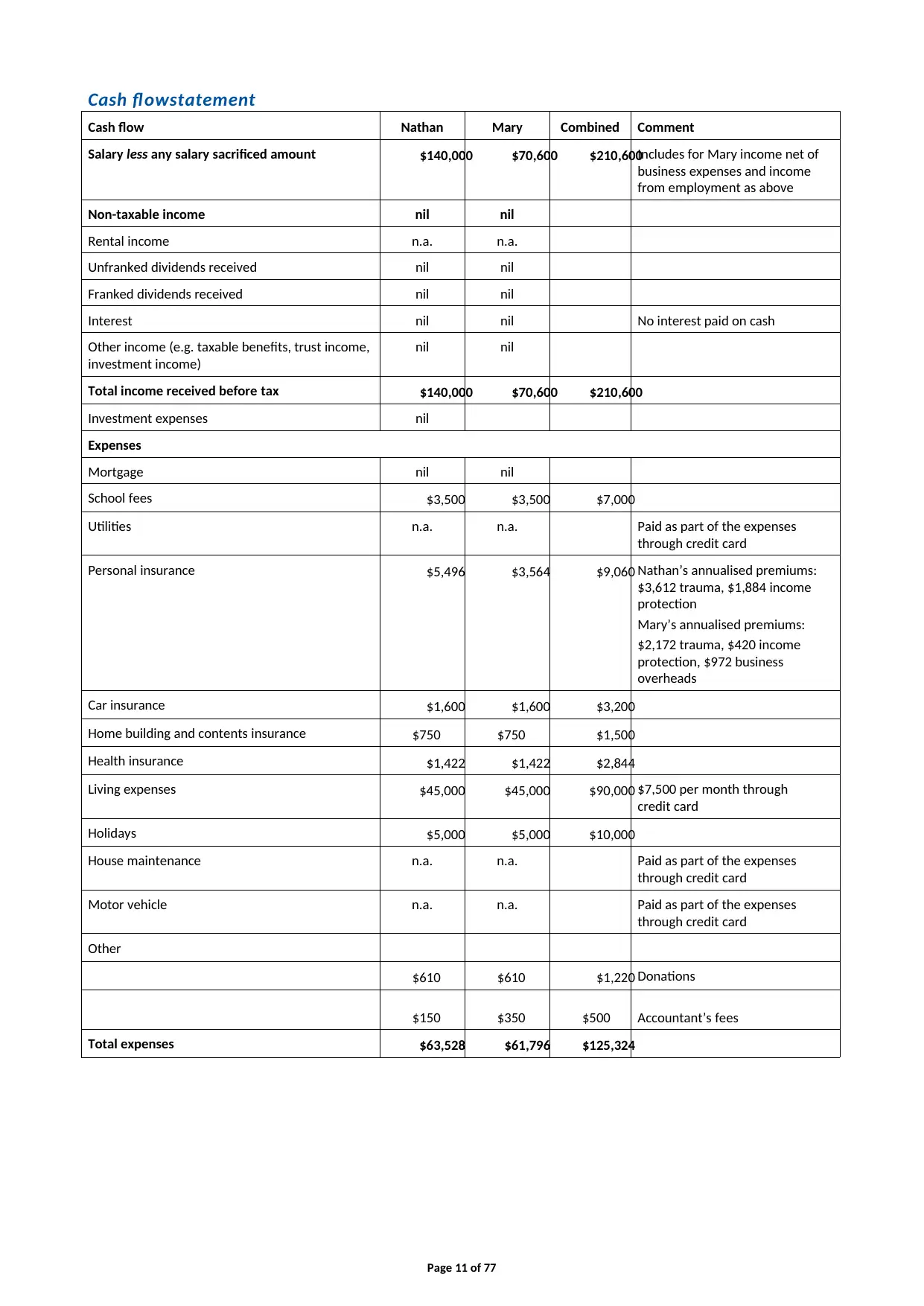
Cash flowstatement
Cash flow Nathan Mary Combined Comment
Salary less any salary sacrificed amount $140,000 $70,600 $210,600Includes for Mary income net of
business expenses and income
from employment as above
Non-taxable income nil nil
Rental income n.a. n.a.
Unfranked dividends received nil nil
Franked dividends received nil nil
Interest nil nil No interest paid on cash
Other income (e.g. taxable benefits, trust income,
investment income)
nil nil
Total income received before tax $140,000 $70,600 $210,600
Investment expenses nil
Expenses
Mortgage nil nil
School fees $3,500 $3,500 $7,000
Utilities n.a. n.a. Paid as part of the expenses
through credit card
Personal insurance $5,496 $3,564 $9,060 Nathan’s annualised premiums:
$3,612 trauma, $1,884 income
protection
Mary’s annualised premiums:
$2,172 trauma, $420 income
protection, $972 business
overheads
Car insurance $1,600 $1,600 $3,200
Home building and contents insurance $750 $750 $1,500
Health insurance $1,422 $1,422 $2,844
Living expenses $45,000 $45,000 $90,000 $7,500 per month through
credit card
Holidays $5,000 $5,000 $10,000
House maintenance n.a. n.a. Paid as part of the expenses
through credit card
Motor vehicle n.a. n.a. Paid as part of the expenses
through credit card
Other
$610 $610 $1,220 Donations
$150 $350 $500 Accountant’s fees
Total expenses $63,528 $61,796 $125,324
Page 11 of 77
Cash flow Nathan Mary Combined Comment
Salary less any salary sacrificed amount $140,000 $70,600 $210,600Includes for Mary income net of
business expenses and income
from employment as above
Non-taxable income nil nil
Rental income n.a. n.a.
Unfranked dividends received nil nil
Franked dividends received nil nil
Interest nil nil No interest paid on cash
Other income (e.g. taxable benefits, trust income,
investment income)
nil nil
Total income received before tax $140,000 $70,600 $210,600
Investment expenses nil
Expenses
Mortgage nil nil
School fees $3,500 $3,500 $7,000
Utilities n.a. n.a. Paid as part of the expenses
through credit card
Personal insurance $5,496 $3,564 $9,060 Nathan’s annualised premiums:
$3,612 trauma, $1,884 income
protection
Mary’s annualised premiums:
$2,172 trauma, $420 income
protection, $972 business
overheads
Car insurance $1,600 $1,600 $3,200
Home building and contents insurance $750 $750 $1,500
Health insurance $1,422 $1,422 $2,844
Living expenses $45,000 $45,000 $90,000 $7,500 per month through
credit card
Holidays $5,000 $5,000 $10,000
House maintenance n.a. n.a. Paid as part of the expenses
through credit card
Motor vehicle n.a. n.a. Paid as part of the expenses
through credit card
Other
$610 $610 $1,220 Donations
$150 $350 $500 Accountant’s fees
Total expenses $63,528 $61,796 $125,324
Page 11 of 77
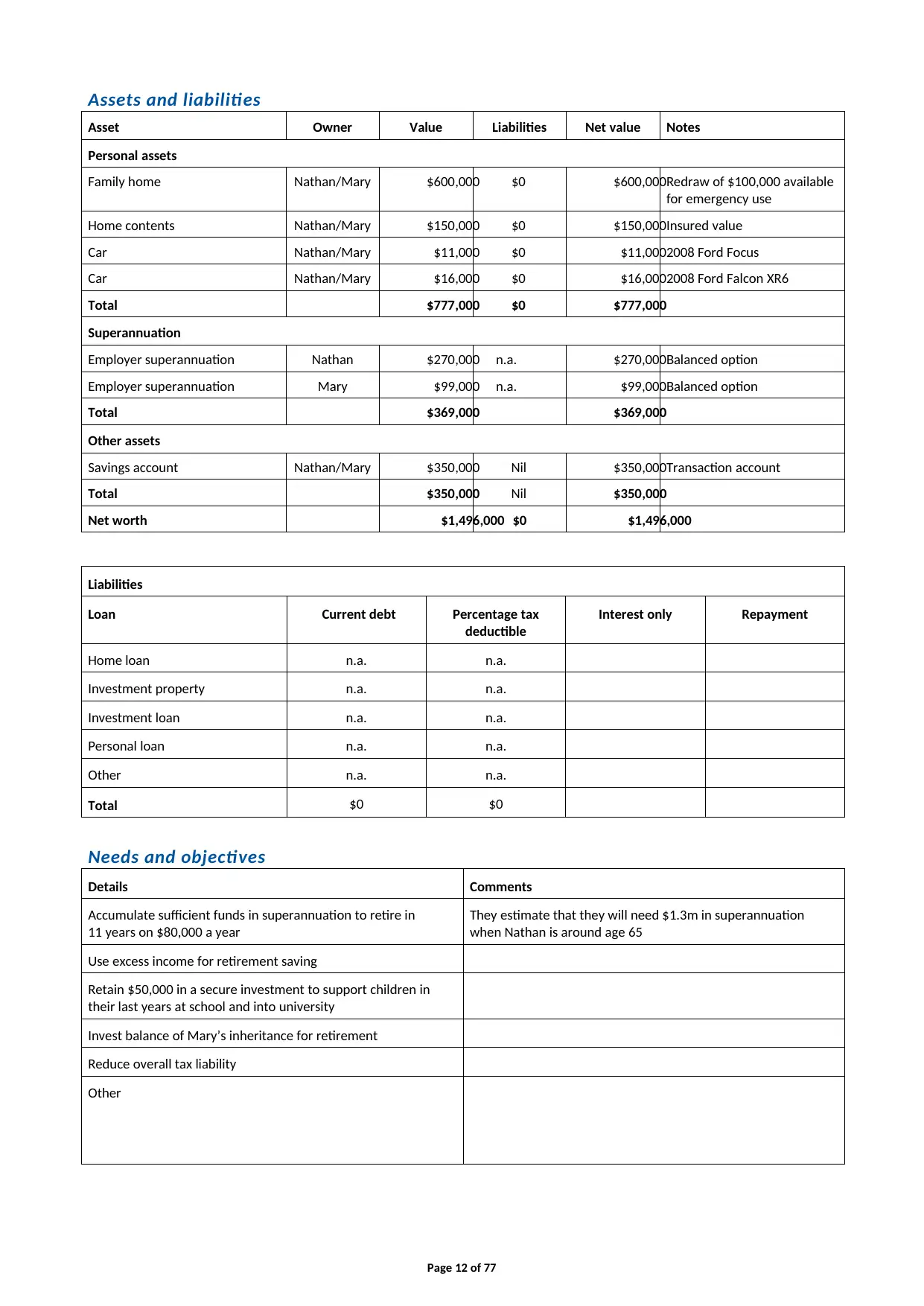
Assets and liabilities
Asset Owner Value Liabilities Net value Notes
Personal assets
Family home Nathan/Mary $600,000 $0 $600,000Redraw of $100,000 available
for emergency use
Home contents Nathan/Mary $150,000 $0 $150,000Insured value
Car Nathan/Mary $11,000 $0 $11,0002008 Ford Focus
Car Nathan/Mary $16,000 $0 $16,0002008 Ford Falcon XR6
Total $777,000 $0 $777,000
Superannuation
Employer superannuation Nathan $270,000 n.a. $270,000Balanced option
Employer superannuation Mary $99,000 n.a. $99,000Balanced option
Total $369,000 $369,000
Other assets
Savings account Nathan/Mary $350,000 Nil $350,000Transaction account
Total $350,000 Nil $350,000
Net worth $1,496,000 $0 $1,496,000
Liabilities
Loan Current debt Percentage tax
deductible
Interest only Repayment
Home loan n.a. n.a.
Investment property n.a. n.a.
Investment loan n.a. n.a.
Personal loan n.a. n.a.
Other n.a. n.a.
Total $0 $0
Needs and objectives
Details Comments
Accumulate sufficient funds in superannuation to retire in
11 years on $80,000 a year
They estimate that they will need $1.3m in superannuation
when Nathan is around age 65
Use excess income for retirement saving
Retain $50,000 in a secure investment to support children in
their last years at school and into university
Invest balance of Mary’s inheritance for retirement
Reduce overall tax liability
Other
Page 12 of 77
Asset Owner Value Liabilities Net value Notes
Personal assets
Family home Nathan/Mary $600,000 $0 $600,000Redraw of $100,000 available
for emergency use
Home contents Nathan/Mary $150,000 $0 $150,000Insured value
Car Nathan/Mary $11,000 $0 $11,0002008 Ford Focus
Car Nathan/Mary $16,000 $0 $16,0002008 Ford Falcon XR6
Total $777,000 $0 $777,000
Superannuation
Employer superannuation Nathan $270,000 n.a. $270,000Balanced option
Employer superannuation Mary $99,000 n.a. $99,000Balanced option
Total $369,000 $369,000
Other assets
Savings account Nathan/Mary $350,000 Nil $350,000Transaction account
Total $350,000 Nil $350,000
Net worth $1,496,000 $0 $1,496,000
Liabilities
Loan Current debt Percentage tax
deductible
Interest only Repayment
Home loan n.a. n.a.
Investment property n.a. n.a.
Investment loan n.a. n.a.
Personal loan n.a. n.a.
Other n.a. n.a.
Total $0 $0
Needs and objectives
Details Comments
Accumulate sufficient funds in superannuation to retire in
11 years on $80,000 a year
They estimate that they will need $1.3m in superannuation
when Nathan is around age 65
Use excess income for retirement saving
Retain $50,000 in a secure investment to support children in
their last years at school and into university
Invest balance of Mary’s inheritance for retirement
Reduce overall tax liability
Other
Page 12 of 77
⊘ This is a preview!⊘
Do you want full access?
Subscribe today to unlock all pages.

Trusted by 1+ million students worldwide
1 out of 77
Related Documents
Your All-in-One AI-Powered Toolkit for Academic Success.
+13062052269
info@desklib.com
Available 24*7 on WhatsApp / Email
![[object Object]](/_next/static/media/star-bottom.7253800d.svg)
Unlock your academic potential
Copyright © 2020–2025 A2Z Services. All Rights Reserved. Developed and managed by ZUCOL.





